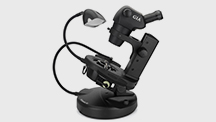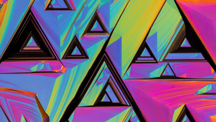Modified Rheinberg Illumination

Lighting control is one of the most important considerations for maximizing the use of the gemological microscope; with greater control over illumination sources, more information may be gathered from observing a specimen. An interesting technique that gives the microscopist another lighting tool is modified Rheinberg illumination, also known as differential color illumination (M. Pluta, Advanced Light Microscopy: Specialized Methods, Vol. 2, PWN-Polish Scientific Publishers, Warsaw, 1989, pp. 113). This method, as modified for gemological microscopy, employs the use of a contrasting color filter between each illumination source and the subject (figure 1) to achieve an “optical staining” effect (figure 2). When viewing crystallographically aligned subjects such as negative crystals or inclusions with well-defined, reflective crystal faces, each illumination source highlights areas that have the same crystallographic orientation (figure 3). This provides dramatic false-color contrast to an otherwise low-contrast subject. This enhanced contrast makes it easier to observe the relationship between areas in an inclusion scene with identical and also differing crystallographic orientations.





